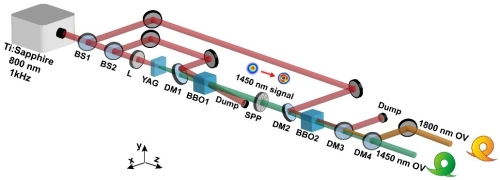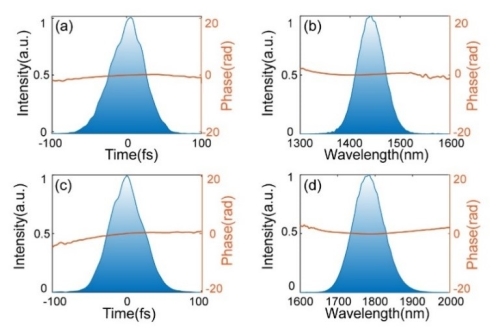The researchers in the State Key Laboratory of High-Field Laser Physics at the Shanghai Institute of Optics and Fine Mechanics (SIOM) of the Chinese Academy of Sciences (CAS) have recently made new progress in the generation of ultrashort vortex pulses. Using spatial phase modulation combined with optical parametric amplification (OPA), the researchers have achieved the output of dual-wavelength ultrashort vortex pulses at near-infrared wavelengths. The related results are published in High Power Laser Science and Engineering on August 22, 2022.
Optical vortex is a spatially structured beam with a spiral wave front, which has a wide range of applications in quantum information, super-resolution microscopy and optical tweezers due to its doughnut spatial intensity distribution and the characteristic of carrying orbital angular momentum (OAM).
In addition, femtosecond vortex light carrying OAM has important applications in driving vortex particle beams and secondary radiation, and in the multidimensional temporal resolution of materials.
However, at present, the main way of generating ultrashort vortex pulses is to use components such as spiral phase plates and spatial light modulators to generate them directly, while vortex pulses generated by optical parametric oscillation (OPO) cannot obtain broadband ultrashort vortex pulses, so the use of OPA can effectively achieve broadband ultrashort vortex pulse generation.
In this study, the researchers combined spatial phase modulation with OPA based on a non-linear frequency conversion technique and exploited the broadband gain advantage of OPA and the conservation of orbital angular momentum to achieve dual-wavelength broadband femtosecond vortex pulses of 1.45 μm and 1.8 μm with pulse energies of 158 μJ and 190 μJ, respectively, and pulse widths of about 50 fs.
This scheme can provide technical support for the further extension of the wavelength of ultrashort vortex pulses to produce higher energy, shorter pulse width and higher average power infrared femtosecond vortex lasers, and provide a basis for the study of ultrafast orbital angular momentum physics.

Figure. 1. Experimental setup. (Image by SIOM)

Figure. 2 Signal light (a) with idler light (c) output vortex spot; signal light (b) with idler light (d) self-referenced interference fringe. (Image by SIOM)

Figure. 3. Time domain and phase of the output pulse of signal light (a) and idler light (c); spectrum and phase of signal light (b) and idler light (d). (Image by SIOM)
Article website:
https://doi.org/10.1017/hpl.2022.20
Contact:
WU Xiufeng
General Administrative Office
Shanghai Institute of Optics and Fine Mechanics, CAS
Email: xfwu@siom.ac.cn
Web: http://english.siom.cas.cn/